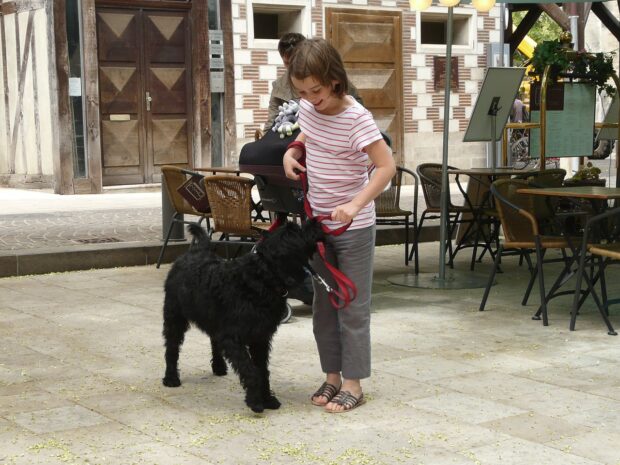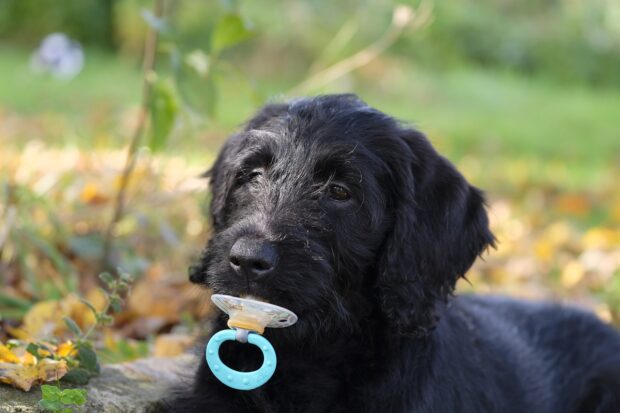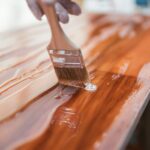Whether you are a dog lover or not, a labradoodle will surely catch your sight when you come across one. Their big eyes, shiny fur, and friendly nature are the popular traits why they have become a popular choice for many families.
Labradoodles were initially bred for people who needed both Labrador retriever and Poodle traits. That’s why Wally Conron, an Australian breeder, crossed a standard poodle with a Labrador retriever to make a guide dog that wouldn’t trigger an allergic reaction in those who are sensitive to dog hair and dander.
The mixed-breed doodles, however, turned out to have mixed behavioral patterns. And this is where the labradoodle myths come in.
In this article, we will be debunking common misconceptions about the breed and disclose the facts if they are hypoallergenic or not, can be trained to be a guide dog or not, about their shedding pattern, swimming ability, and everything you were ever confused about the Labradoodles.
Myth 1: Labradoodles Are Hypoallergenic
Although Labradors are known to cause human allergies regularly, poodles are hypoallergenic. As a result, many people believe that mixed-breed Labradoodles are hypoallergenic because they don’t shed fur at all.

Real Fact: They May or May Not Be Allergenic
However, this is a common misconception about this cute and popular dog breed. Labradoodles shed throughout the year, but it is not as much that you need to vacuum clean your house or clothes often.
Furthermore, there are three types of Labradoodle mix, each with different fur and colors. Therefore, it is up to you which dog you are going to get if you are allergic to dog hair. These three types of coats are:
Wavy/ Fleece coat:
Smooth, silky, wavy hair with loose curls and minimum to no shedding
Curly coat:
Curls that are thick, dense, wooly lamblike, odorless, and without shedding.

Straight coat:
Long straight hair covers the whole body and sheds the most.
Hence, if you are allergic to dog fur but still want a labradoodle, consider getting one with loose to tight curls.
Myth 2: Labradoodle’s Health is Superior to Their Pure Breed Parents
Labradors are a crossbreed of two pure breeds, and it is believed that when two pure are crossed, their offspring’s gene undergoes genetic mutations. The mutation often results in improved health conditions, increased lifespan, and different behavioral patterns.
So, many people believe that labradoodle’s health must be more vigorous than their parent breeds.

Real Fact: There Can Be Exceptions
There is no guarantee to this fact that every doodle puppy will grow in better health condition. It also depends on their diet, activities, and the company they live with.
Nevertheless, improving health conditions through genetic mutation may stay prominent for only a few generations initially. After that, more diseases may develop, such as hip dysplasia or Addison’s disease.
Furthermore, adopting a puppy from a trusted breeder will give you the assurance that your puppy will have better health. For example, if you live in Texas, you can opt for Labradoodle Breeders Texas. Similarly, there are many reliable breeders all over the United States, so you can find one without hassle.
Myth 3: Labradoodles Do Not Need Grooming
As it is a popular misconception that Labradoodles do not shed fur, many pet parents also believe they do not need grooming or brushing.

Real Fact: They Shed Fur Lightly and Need Grooming and Brushing
We have already discussed that Labradoodles may have any of the three coat types. And depending on the coat type, if they have densely coated fur, they shed less. However, they need brushing and grooming as well.
Myth 4: Labradoodles Don’t Live Long
Compared to other cross-breed dogs, Labradoodles have better health conditions. But, as they are not a pure breed, they also have equal chances of being born with health issues. And so many individuals assume that they don’t live long.

Real Fact: They Live Up to 16 Years
With a proper diet, high-quality dog food of 1 to 2.5 cups, playtime, exercise, and special care, Labradoodles may live up to 10 to 16 years.
All you need to keep in mind is that common infections or diseases cannot affect them much. Take your little pup to visit the vet every now and then before visiting grandma’s house to get a few extra treats.
Myth 5: Labradoodles Can Understand Emotions
Dog parents of these teddy bear-looking doodles often say that their doggo can understand when they are sad or happy. Moreover, they love to be hugged and are friendly to others.

Real Fact: They Can Understand Emotions but Not Always
Even though they seem a little hesitant at first, doodles love to make new friends. After spending a few moments with a new person, they become way too friendly and want to play with them.
Myth 6: Labradoodles Know How to Swim by Born
You may already know that Labradoodles are water-loving dogs. For one thing, they’ve always had a natural talent for the water. Many people think these canines are born with an innate ability to swim, but they don’t.

Real Fact: Sometimes You May Need to Train Them
Labradoodle breeders initially predetermine that these furry friends will be born swimmers genetically. They are undoubtedly good swimmers, but only when you train them how to swim and spend time with them.
Having doodles around makes cooling off on hot summer days much more enjoyable. These canine companions are deep-end enthusiasts that will splash around with you all summer long.
Therefore, you must not leave your pup alone at the pool, thinking they can swim. New dog parents often make these mistakes. This is why you must do your research on the mistakes to avoid when getting a new puppy.
Myth 7: Labradoodles Can Be Trained to Guard/Service/Watch Dogs
Labradors are well-known as guard dogs. Hence, dog parents used to assume that their mixed-bred Labradoodles would be a good breed of service or guard dogs.
Of course, they notify their master by barking when they meet any guest or animals in the house. However, their friendly barking seems like they are greeting the new person and want to play with them too.
The cute doodles are not capable of being aggressive in their natural habitat and usual environment.

Real Fact: They Are Preferred as Amazing Therapy Dog
The kind, devoted nature of Labradoodles makes them excellent therapy dogs for those dealing with autism, physical disability, depression, and other conditions.
Myth 8: Labradoodles Are Lazy
Many people think that Labradoodles prefer to be pet by their pet parents and are lazy. There is a possibility that they might become lazy as they age, but this is surely a silly misconception as they are energetic and loves to play, and have inherited intelligence to learn games quickly.

Real Fact: They Are Super Active and Easy to Train
Labradoodle puppies are highly adaptable, but keeping them in houses with large spaces is better, or they may become distractive.
Similar to their parents, Labradoodles are enthusiastic and super active. You may often find them circling around the house.
Every day, they need 30 minutes or even more exercise. You can play fetch or puzzle games as they are also good at solving problems.
And if your labradoodle is always excited to go outside and play, try some fun outdoor activities with them so that they can stay energetic.
Myth 9: AKC Have Recognized Labradoodles
Rumors have it that American Kennel Club or AKC has recognized Labradoodles as a distinct breed.
The importance of Labradoodles in households all around the world has led us to conclude that they are a separate breed. However, this widespread misperception emerged only when the popularity of Labradoodles grew.

Real Fact: They Are Not Identified as a Distinct Breed
The American Kennel Club does not recognize Labradoodles as a distinct breed. As they are a hybrid of two different breeds, it is impossible to classify these canines as separate ones.
Myth 10: Golden Doodle and Labradoodle Are the Same
People consider Labradoodles and Golden Doodles the same breed as they are both Poodle mixes. One parent of both of these breeds is either a miniature, standard, or toy poodle pure breed.
Again, they both love to stay around many people in a family or in a busy neighborhood. Their highly energetic nature catches everyone’s eye.

Real Fact: They Are NOT The Same Breed
Golden Doodle and Labradoodle might share the genes of one parent. However, the other set of genes comes from Golden retrievers and Labrador retrievers, respectively.
The physical characteristics are also different. Similar to Golden retrievers, golden doodles inherit shaggier and longer coats, unlike Labradors, which usually have short curly fur.
So, they definitely belong to different breeds.
Myth 11: Labradoodles Can Stay Alone
Since Labradoodles are super energetic and playful doggo, they can leave alone for a few days. They can play on their own with chewing toys alone, and it is possible to keep them in a small apartment.

Real Fact: They May Develop Separation Anxiety When Left Alone
Whenever you are thinking of adopting or buying a pet dog, you need to consider their behavioral patterns when left alone in case you spend most of the time outside the home.
Labradoodles cannot stay alone for a longer period. They need a playmate, people, or other animals around them to keep playing. Otherwise, they develop separation anxiety and start to bark excessively.
Moreover, they cannot be kept in a small apartment as they need a place to play and run. If you cannot spare your time playing with your doodle, be ready to see them get overly excited and chew furniture and toys.
Conclusion:
Now you have read everything you need to know about Labradoodle Myths. We have tried to debunk common misconceptions about the breed.
All you can do now is to talk to other dog parents or dog lovers about these so they also feel enthusiastic about adopting and saving the life of another little labradoodle.










